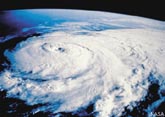
|
|
Information and History
|
The Future of Polar-orbiting Satellites:
On May 5, 1994, President Clinton made the landmark decision to merge the
nation's military and civil operational meteorological satellite systems into a
single, national system capable of satisfying both civil and national security
requirements for space-based remotely sensed environmental data. Convergence of
these programs is the most significant change in U.S. operational remote sensing
since the launch of the first weather satellite in April 1960.
For the first time, the U.S. government is taking an integrated approach to
identifying and meeting the operational satellite needs of both the civil and
national security communities. The joint program formed at President Clinton's
direction is the National Polar-orbiting Operational Environmental Satellite
System (NPOESS). It is expected to provide more than $1.8 billion savings in
acquisition and operational costs through the System Life Cycle of the program
compared to the cost of continuing the planned separate satellite systems within
the Departments of Defense and Commerce.
The U.S. government has traditionally maintained two operational weather
satellite systems, each with a 30-plus year heritage of successful service: NOAA's
Polar-orbiting Operational Environmental Satellite (POES), and DoD's Defense
Meteorological Satellite Program (DMSP). Recent changes in world political
events and declining agency budgets prompted a re-examination of combining the
two systems.
On Oct. 3, 1994, NOAA, DoD, and NASA created an Integrated Program Office (IPO)
to develop, manage, acquire, and operate the NPOESS system. The Integrated
Program Office concept provides each of the participating agencies with lead
responsibility for one of three primary functional areas. NOAA has overall
responsibility for the converged system and is also responsible for satellite
operations. NOAA is also the primary interface with the international and civil
user communities. DoD is responsible to support the IPO for major systems
acquisitions, including launch support. NASA has a primary responsibility for
facilitating the development and incorporation of new cost-effective
technologies into the converged system. Although each agency provides certain
key personnel in their lead role, each functional division is staffed by
tri-agency work teams to maintain the integrated approach.
As an early step in the convergence process and the first tangible result of
the NPOESS effort, Satellite Control Authority for the existing DMSP satellites
was transferred in May 1998 from the U.S. Air Force Space Command to the NPOESS
Integrated Program Office. The command, control, and communications functions
for the DMSP satellites have been combined with the control for NOAA's POES
satellites at NOAA's Satellite Operations Control Center (SOCC) in Suitland, Md.
The DMSP satellites are being Aflown@ by civilian personnel at the SOCC. This is
the first time in the 30-plus-year history of this DoD program that the DMSP
satellites have not been flown by Air Force personnel. A backup satellite
operations center, manned by USAF Reserve personnel, was established at
Schriever Air Force Base, Colo. This interagency team effort has provided the
U.S. government with new, state-of-the-technology satellite control equipment
that is Year 2000 compliant, and has resulted in significant budgetary savings,
as well as uninterrupted service to the end users.
On Dec. 13, 1999, a new Department of Defense meteorological satellite was
launched by the U.S. Air Force and is being operated by NOAA. The satellite is
the next in a series of the Defense Meteorological Satellite Program. This is
the first DMSP whose post-launch checkout was conducted from NOAA's Satellite
Operations Control Center in Suitland, Md.
The first converged NPOESS satellite is expected to be available for launch
in the latter half of the decade, approximately 2008, depending on when the
remaining POES and DMSP program satellite assets are exhausted. NPOESS will
provide significantly improved operational capabilities and benefits to satisfy
the Nation's critical civil and national security requirements for space based,
remotely sensed environmental data. NPOESS will deliver higher resolution and
more accurate atmospheric and oceanographic data to support improved accuracy in
short-term weather forecasts and warnings and severe storm warnings, as well as
serve the data continuity requirements of the climate community for improved
climate prediction and assessment. NPOESS will also provide improved
measurements and information about the space environment necessary to ensure
reliable operations of space-based and ground-based systems, as well as continue
to provide surface data collection and search and rescue capabilities.
Home | Operations |
News | Daily Updates |
Info & History
GOES | POES |
DMSP | Contact Us |
Webmaster
Privacy Policy
|
|
 |


 DOC
NOAA
NESDIS
DOC
NOAA
NESDIS



 DOC
NOAA
NESDIS
DOC
NOAA
NESDIS
